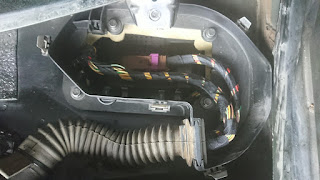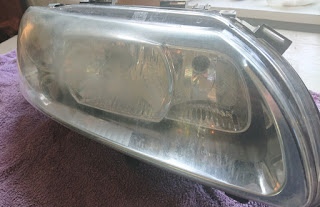The rear wheel hubs are secured in the forward direction by the trailing arm. The front part of the arm is connected to the subframe by a bushing. The old version of the bushing looks like this:
It's a rubber bushing with gaps on each side to prevent vibrations. However, these bushings tend to get soft in time, with a lot of play. Or the rubber may break completely. This will allow the rear wheels to begin steering, especially on tracked roads or when cornering. The car may start to wander from side to side and you get the feeling that you will lose the control of the vehicle.
Volvo upgraded this bushing. Now, the bushing has no gaps on each side. It is completely filled with rubber. If your bushings are bad, you want to replace them.
The bushing itself is cheap. But to get to the bushing, you have to face the following question: Do you want to to it the hard way, or the easy way?
The common way, the official way according to VIDA, is the hard way. The problem is that the bushing sits in the subframe, not in the trailing arm. The bushing is in a tight spot, so you are not able to access it with conventional pressing tools. Therefore VIDA calls for removing the exhaust system, propeller shaft (on XC70), hoses and pipes connected to the subframe, and to lower the complete subframe.
Wow! My Volvo dealer offered to do the job for $30 in parts and $1000 for labor. If you choose to do it the hard way, you can watch this YouTube clip:
Still reading? Oh, you want to do it the easy way?
The easy way involves no press tools and not lowering the subframe. Instead it involves a different kind of bushing. A 2-part PowerFlex bushing:
This bushing consists of 2 polyurethane parts. You press each part in place, from each side. And then you push in a metal tube that goes through both bushing parts. You need 2 packs to cover both sides.
If you choose the easy way you can do it like this:
Remove the wheel. Disconnect the rear end of the trailing arm. The hub has some tension, so it will jump off. Then disconnect the trailing arm completely. If there is a bracket that prevents you from accessing the front bolt, you have to loosen the bracket.
Use a reciprocating saw to saw out the old bushing. This is the most difficult part. You don't get a straight angle on the saw. You probably are going to scratch up the bushing housing, but hey - it's aluminum...
Clean the housing and grease it up with the grease that comes with the new bushing. Push in the new 2-part bushing, either by hand or with a polygrip or something. Grease up the metal tube and push it inside the bushing.
Connect first the front end of the trailing arm. To manage to connect to rear end you have to use some force. I used a breaker bar to force the hub forward. On this picture I use a screwdriver to demonstrate how I did it:
Insert a flat and wide breaker bar like this and push downwards. After this job is complete you should get a 4 wheel alignment. The final result looks like this:
The bushing is a bit more expensive, and you have to use a reciprocating saw. But this way is WAY more easy!











































